-
Paper Information
- Paper Submission
-
Journal Information
- About This Journal
- Editorial Board
- Current Issue
- Archive
- Author Guidelines
- Contact Us
Geosciences
p-ISSN: 2163-1697 e-ISSN: 2163-1719
2021; 11(1): 10-42
doi:10.5923/j.geo.20211101.02
Received: May 31, 2021; Accepted: Jun. 21, 2021; Published: Jun. 30, 2021

Impact of Sensor Networks on Aquatic Biodiversity in Wetland: An Innovative Approach
Md Rahimullah Miah 1, Alexander Kiew Sayok 2, A. A. M. Shazzadur Rahman 3, Alamgir Adil Samdany 4, Foujia Akhtar 5, Abul Kalam Azad 6, Md Mehedi Hasan 7, Md Shahariar Khan 8, Md. Sher-E-Alam 9, Mohammad Shamsul Alam 10, Mohammad Basir Uddin 11, Fuad Abdullah 12, Chowdhury Shadman Shahriar 13, Mir Abu Saleh Shamsuddin 14, Mohammad Belal Uddin 15, Ahi Sarok 16, Ishrat Tasnim Rahman 17, Shahriar Hussain Chowdhury 18, Motia Begum 19
1Department of IT in Health, North East Medical College, Sylhet, Bangladesh and PhD Awarded from IBEC, UNIMAS, Malaysia
2IBEC, Universiti Malaysia Sarawak (UNIMAS), Kota Samarahan, Sarawak, Malaysia
3Department of Medicine, North East Medical College, Sylhet, Bangladesh
4Department of Orthopedics, North East Medical College, Sylhet, Bangladesh
5Department of Economics, Moulvibazar Govt. Women’s College, Moulvibazar, Bangladesh
6Department of Chemistry, Sylhet Govt. Women’s College, Sylhet, Bangladesh
7Department of Law, Green University of Bangladesh, Dhaka, Bangladesh
8Department of Paediatrics, North East Medical College, Sylhet, Bangladesh
9Department of Law, Metropolitan University, Sylhet, Bangladesh
10Department of Forensic Medicine, North East Medical College, Sylhet, Bangladesh
11Department of Paediatric, North East Medical College, Sylhet, Bangladesh
12Faculty of Science, Memorial University of Newfoundland, Canada
13USMLE Student, USA and Ex-student of North East Medical College, Sylhet, Bangladesh
14Chittagong Government Teachers’ Training College, Chittagong, Bangladesh
15Department of Forestry and Environmental Science, Shahjalal University of Science and Technology, Bangladesh
16Faculty of Social Science, Universiti Malaysia Sarawak, Kota Samarahan, Sarawak, Malaysia
17Ananda Niketan, Sylhet, Bangladesh
18Department of Dermatology, North East Medical College, Sylhet, Bangladesh
19Lawyer, District Judge's Court, Sunamganj, Bangladesh
Correspondence to: Md Rahimullah Miah , Department of IT in Health, North East Medical College, Sylhet, Bangladesh and PhD Awarded from IBEC, UNIMAS, Malaysia.
| Email: |  |
Copyright © 2021 The Author(s). Published by Scientific & Academic Publishing.
This work is licensed under the Creative Commons Attribution International License (CC BY).
http://creativecommons.org/licenses/by/4.0/

Aquatic biodiversity is in the central field of environmental conservation issues in a wetland. Yet it determinately faced aquatic conservation authorities the loss of biodiversity as a very important global issue for several years due to misuse wireless sensor technology. The study attempts to re-look at the sensor networks that affect the aquatic biodiversity within and around the Tanguar Haor- wetland study at Sunamganj district in Bangladesh. Key aquatic conservation tools provided at the Tanguar Haor and its challenges with gaps in policies for wetland management practices are highlighted. The study shows the aquatic biodiversity-related rules and regulations amended were apex in Bangladesh from 2010 to 2018. The study represents the impact of processed sensor networks on aquatic biodiversity in a wetland to be compared to larger, medium, and smaller animals in a bright, dark and optimum environment, facilitating the design and misuse of wireless sensor networks within GPS locations. Approximately 64% of the respondents agreed on the development of aquatic biodiversity for managing the wetland at Sunamganj with secure peripheral sensor networks. The research also found that the Tanguar Haor is at risk due to misuse of wireless sensor networks compared to other wetlands in the Sylhet Division. Scientific knowledge is indispensable in wetland resource management but it poorly identified such knowledge while various performances are still below par. The research is unique and represents the innovative idea to improve the existing wetland policy linking with the appropriateness for the Ramsar Wetland Conservation Strategy.
Keywords: Biodiversity, Sensor Network, Wetland, Tanguar haor, Ramsar
Cite this paper: Md Rahimullah Miah , Alexander Kiew Sayok , A. A. M. Shazzadur Rahman , Alamgir Adil Samdany , Foujia Akhtar , Abul Kalam Azad , Md Mehedi Hasan , Md Shahariar Khan , Md. Sher-E-Alam , Mohammad Shamsul Alam , Mohammad Basir Uddin , Fuad Abdullah , Chowdhury Shadman Shahriar , Mir Abu Saleh Shamsuddin , Mohammad Belal Uddin , Ahi Sarok , Ishrat Tasnim Rahman , Shahriar Hussain Chowdhury , Motia Begum , Impact of Sensor Networks on Aquatic Biodiversity in Wetland: An Innovative Approach, Geosciences, Vol. 11 No. 1, 2021, pp. 10-42. doi: 10.5923/j.geo.20211101.02.
Article Outline
1. Introduction
- Aquatic Biodiversity is in the core field of environmental issues in wetland management [1,2,3,21]. Wetlands deal with habitat for thousands of aquatic and terrestrial species community living in the soil surface through controlling floods [22]. Moreover, wetlands also engage additional sediment, nutrients, and other pollutants before they attach in lakes, canals, rivers and other water bodies [31]. But these wetlands are losing its habitat and biodiversity at an alarming rate and it augments day by day due to unwanted reasons. Some scientists remain in mysterious exploring the root causes. So, the problem of loss of biodiversity has been raised as a very important global issue for several years due to the lack of dynamic policies, technological application, institutional support, and stakeholder engagement [1,2,3,4]. This study aimed to assess the wetland policy instruments including legal, in-situ, and informational instruments for conserving biodiversity through primary and secondary data analysis at Tanguar Haor Wetland (THW) in Sunamganj district, Bangladesh. Key conservation innovative instruments provided at the THW and its challenges with gaps in policies and cutting-edge sensor technology for wetland management are highlighted.
2. Criteria of Processed Wireless Sensor Networks
- Today’s world is in the science and technology [5,6,7,8,9,10,11,12,21]. Everyone uses sensor technology, but none can know its impact in daily life [1,2,5,7,21], which identifies in higher study research because of active open eyes, self-voice, fixed GPS location, cell phone tower, and individual’s sensor devices. The processed wireless sensor networks affect biodiversity within fixed GPS location using active open eyes, noise, or beside sensor device, which is formed as ISNAB Effect. ISNAB implies the Impact of Sensor Networks towards Aquatic Biodiversity with climate change and environmental issues. To identify the impact of sensor towards aquatic biodiversity, the experiment was continued on dog, cat and fish species capturing showed within GPS distances to track with node sensor and distributed sensor, which illustrates in Figure 1 and Figure 2 successively. The tracking includes as below:(a) Individual species selection and tracking, (b) Group species selection and tracking (c) Fixed GPS selected location and tracking, (d) Satellite selected location and tracking.
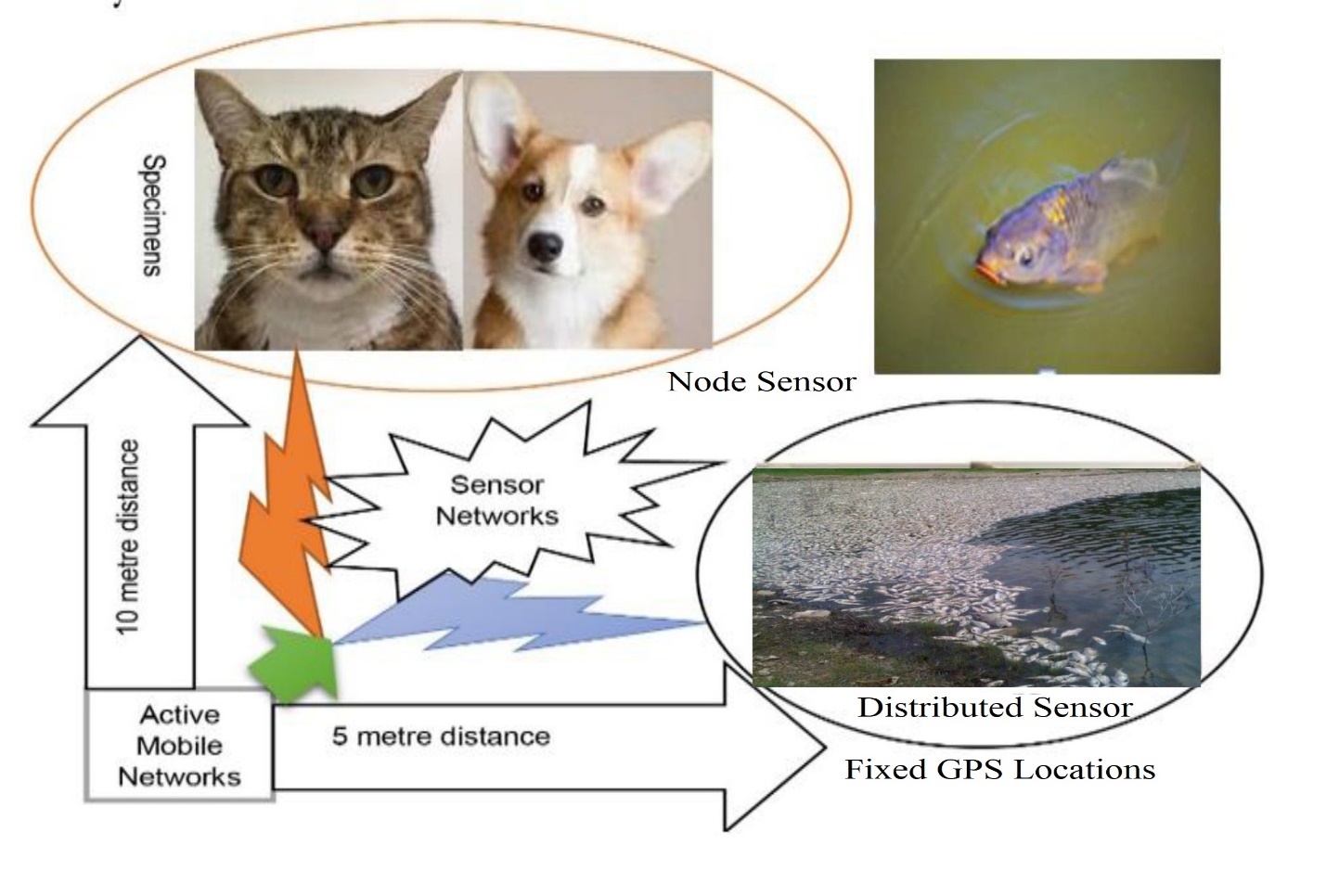 | Figure 1. Species Capturing at GPS distance with Sensor Camera [9,11] |
 | Figure 2. Impact of Sensor Networks towards aquatic biodiversity at wetland [21] |
3. Assessment of the Results Achieved
- The results relate with data analysis and interpretation. Quantitative and qualitative related aquatic conservation data were obtained through field observation, interviews, field surveys, focus group discussions, informal discussion, and lab experiment while secondary data were obtained from diverse sources. The study shows the aquatic biodiversity-related rules and regulations amended were apex in Bangladesh from 2010 to 2020. The study represents the impact of processed sensor networks on aquatic biodiversity in the wetland to be compared to larger, medium, and smaller animals in a bright, dark, and optimum environment, facilitating the fluctuated network design and misuse of wireless sensor networks towards aquatic GPS locations, which as shown in Figure 3.
 | Figure 3. Impact of processed sensor networks wetland aquatic biodiversity |
 Processed water sensor separates hydrogen and oxygen due to presence of electrolysis. Hydrogen burns and oxygen help to burn. In this fixed GPS location, increase carbon-dioxide due to presence of CO2 sensor. From the research, it identified the processed sensor technology blocks oxygen transmission, blood circulation and water flow in living cells. Because of blockage electron, the individuals suffer from acute respiratory distress sysndrome (ARDS). After stipulated time, the individual died through processed node sensor and group of individuals died through distributed sensor according to BMI categories at dark and light environments. The study shows that Automated Radio Telemetry System is more effective in the dark than in light environment on aquatic sensoring with digital poisoning. It was observed that in the dark environment, the examined aquatic animals could not breath properly after 15 and 7 minutes of exposure respectively. They fell asleep within 25 and 12 minutes respectively as they were sensored by RFID (Fig 4). Further adverse impacts are expected with longer exposure. During medication time, pond fishes felt pain at their tracheas/gills and other organs coupled with cold-coughing and fluctuated existing temperatures. The wireless sensor networks transmitted also had caused pain in their tracheas/gills (Fig. 5). The use of sensor technology has also resulted in the society to protect aquatic animals in existing environment.
Processed water sensor separates hydrogen and oxygen due to presence of electrolysis. Hydrogen burns and oxygen help to burn. In this fixed GPS location, increase carbon-dioxide due to presence of CO2 sensor. From the research, it identified the processed sensor technology blocks oxygen transmission, blood circulation and water flow in living cells. Because of blockage electron, the individuals suffer from acute respiratory distress sysndrome (ARDS). After stipulated time, the individual died through processed node sensor and group of individuals died through distributed sensor according to BMI categories at dark and light environments. The study shows that Automated Radio Telemetry System is more effective in the dark than in light environment on aquatic sensoring with digital poisoning. It was observed that in the dark environment, the examined aquatic animals could not breath properly after 15 and 7 minutes of exposure respectively. They fell asleep within 25 and 12 minutes respectively as they were sensored by RFID (Fig 4). Further adverse impacts are expected with longer exposure. During medication time, pond fishes felt pain at their tracheas/gills and other organs coupled with cold-coughing and fluctuated existing temperatures. The wireless sensor networks transmitted also had caused pain in their tracheas/gills (Fig. 5). The use of sensor technology has also resulted in the society to protect aquatic animals in existing environment.  | Figure 4. Schematic Capturing Process on the Misuse of Wireless Sensor Networks on Fish |
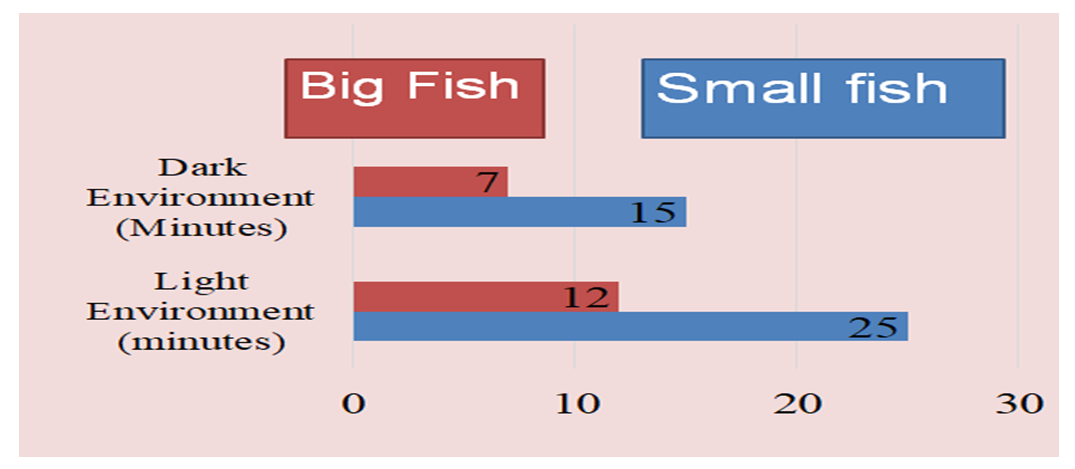 | Figure 5. Sensor affected fishes at fixed GPS locations |
4. Major findings of ISNAB Effect
- Four postulates identified from this ISNAB research, such as:(1) Any person, animal, object, environment, or climate of the existing area dies, damages, or burns in misuse of sensor technology within a fixed GPS location or distributed satellite position at a real-time sensor-organ.(2) The position of any person, animal, or object is known in light and darkness because of the individual’s active open eyes, speech, sound, adjacent sensor device and GPS fixed location.(3) Daily activities of the sensed individuals, animals or objects observe and record what they are doing or uttering in the dark and light at a certain distance with the help of sensor technology in the network and without network but fixed GPS location and GNSS (Global Navigation Satellite System) distances.(4) The targeted individuals or animals infected with various diseases and disease outbreaks through tracking in processed frequencies from sensor technology. But if the person or animal closes its eyes tightly from the affected area and immediately moves to a new place with personal area network control unit (PANCU), wetland area network control unit (WANCU) devices or stays without a network zone and, it remains unaffected.These effects are illustrated with photographs in Appendices in the paper.
5. Develop 7R’s Policy for Wetland Management with Innovative Approach
- From the study, it is identified that the 7R’s Policy is essential for wetland aquatic biodiversity conservation [19,20,21,32] with ISNAB (Impact of Sensor Networks on Aquatic Biodiversity). Here includes seven parameters rule indicating first letter capital “R” as shown in Figure 4. such as (i) Reformation integrated policy in connection with forest policy, environmental policy, and relevant other policies, (ii) Restoration wetland, (iii) Replacement Invasive Alien Species (including plant invasion and wildlife invasion), (iv) Reforestation with biodiversity targets indicates on afforestation for forestation on the priority of Aichi Biodiversity Targets 2020, (v) Reintegration of communities commitment (i.e. they are mainly local, indigenous, visitors and national communities as well as regional and global communities), (vi) Reuse secure sensor technology i.e. application of digital technology and biodiversity information systems, (vii) Recover valuable resources (i.e. using secure information management systems for the protection of natural resources), which are shown in Figure 6. The research explores for update wetland policy, UNCLOS (United Nations Convention on the Law of Sea) declaration, Clearing House Mechanism of CBD (Convention on Biological Diversity) and national biodiversity policy in connection with secure sensor technology. The wetland management policy integrates with United Nations General Assembly (UNGA), UNCLOS, CBD, IUCN [33,34,35], IPBES, International Centre for Trade and Sustainable Development (ICTSD), American Society for International Law (ASIL), United Nations Fish Stock Agreement (UNFSA), Safety of Life at Wetland (SOLAW), Institute of World Wide Radio Navigation System (IWWRNS), Bangladesh Forest Department, Transparency International Bangladesh (TIB), Association for Land Reform and Development, (ALRD), Bangladesh Environmental Lawyer Association (BELA), Bangladesh Institute of Planners (BIP), Centre for Environmental and Geographic Information Service (CEGIS), Norwegian Institute for Nature Research (NINA) [29] and Wetland Area’s Partner NGOs. Policy integration includes wetland policy, environmental, forest, agriculture and ICT policy for advancement of Biodiversity Protection.
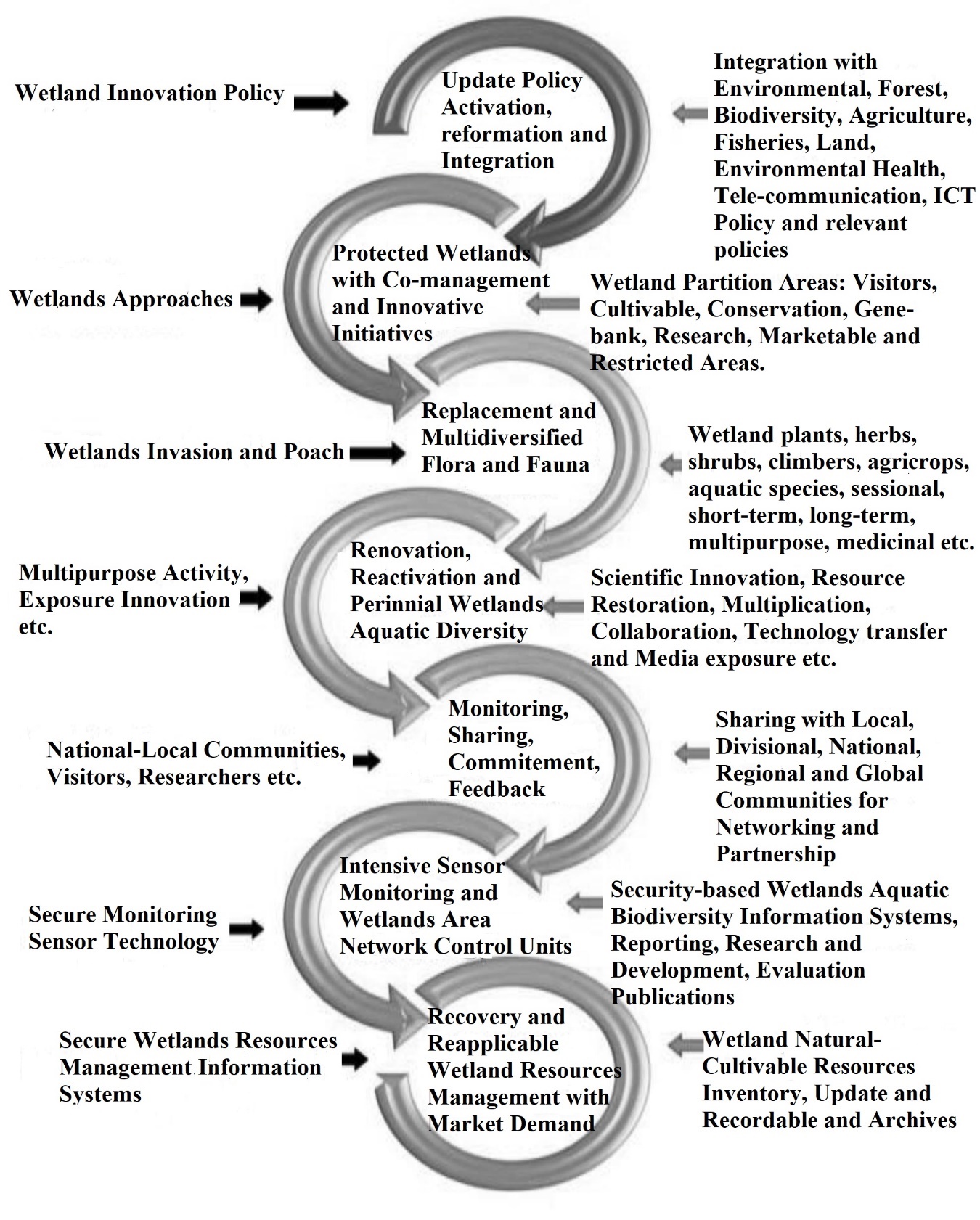 | Figure 6. Wetland Innovation Approach |
6. Potentiality
- Wetlands are one of the world’s key natural resources [36]. But these natural resources destroyed due to missuing of sensor technology. Today’s wireless sensor technology and market economy enter with their own ‘laws’ against nature and feeling proud to be able to win through ISNAB commercialising. Scientific Technological knowledge of ISNAB is indispensable for aquatic biodiversity management in wetland and aquaculture farm areas. Key aquatic conservation tools provided at the Tanguar Haor and its challenges with gaps in policies on using wireless sensor networks for wetland management are highlighted. The study represents the impact of sensor networks on aquatic biodiversity to be compared to larger, medium and smaller animals in a bright, dark and optimum potential environmentally. The ISNAB will enhance conservation network connectivity and security in wetland protected areas and corridors as well as improve commercialization on aquatic biodiversity perspectives that the State provides. It can also enhance security systems for aquaculture farm managers, field officers, visitors, scientists, researchers, wetland co-management team leader and other relevant stakeholders. The research also found that the Tanguar Haor is in risks due to misuse of sensor networks compared to other wetlands in Sylhet division. Experts have tried to implement ways of reducing this impact by encouraging farms to go competitive market with digital conservation through alternative potentiality. Large potential on conservation technology uses including learning, research, business and access benefit sharing to achieve specific goals related to national fisheries rules and regulations Aichi Biodiversity Targets 2020 and Sustainable Development Goals 2030.
7. Novelty
- The novelty of this research is unique in the entire world. Quick sensor network affected towards aquatic biodiversity. Disseminate the distributed sensor network to the whole Animal Farm / Fish pond through individual or group wise. Large animals are more prone to be negatively affected by sensor telematics network because of peripheral congested environment and splitting high frequency with joining stages. These sensor networks use with GPS control unit. The radio frequencies of telematics (500 to 999 mHz and above) were detected using Automated Radio Telemetry System within the 5- and 10-meter distances. Exposure high RFID (radio frequency identification) technology detects to die individual or group aquatic biodiversity.
8. Recovery and Restoration
- For recovery and restoration of wetland innovation approach enhances with diversified parameters [2,9,10,11,12,13,14,15,16,17,18], which illustrates in Figure 7. The wetland resource strategy framework contains different components including (i) recovery components, (ii) sensor health quality services, (iii) sensor trained-up stakeholders, and (iv) sensor control ecological zone.
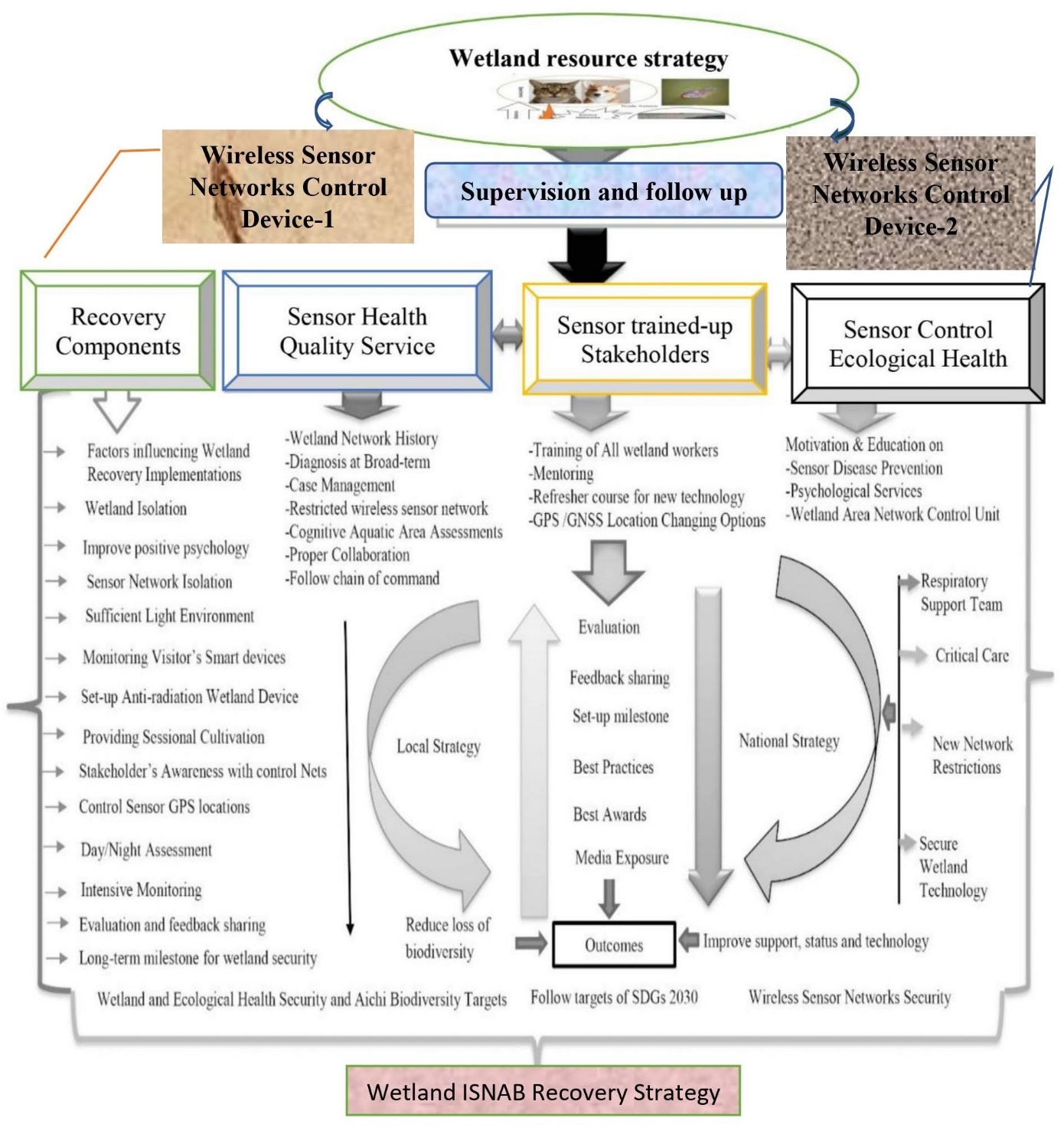 | Figure 7. Recovery Model from ISNAB Effect towards Wetland Aquatic Biodiversity |
9. Innovative Control Approach
- Tanguar haor is a unique wetland ecosystem in Bangladesh that has been recognized as an area of national and international importance and attention [37]. For global recognition, every State set-ups wetland area network control unit (WANCU) according to national wetland policy and sustainable development goals 2030. The WABCU consists of (i) anti-sensor network devices, (ii) Restricted GPS sensor devices, (iii) Restricted GNSS devices, (iv) Restricted Mobile Phone Tower, (v) Restricted visitor’s SMART phone and sensor devices, which as shown in Figure 8. Wetland security forces must wear anti-radiation sunglasses, anti-radiation body control device, close circuit spectacles and use dynamic LASER gun for protection of aquatic biodiversity. During monitoring period, no mobile phone/wireless kit, no uttering words and no electronic devicese consists in each security force. Community-based management enhances this monitoring linking with local people, visitors, researchers and other stakeholders in wetland zone [27].
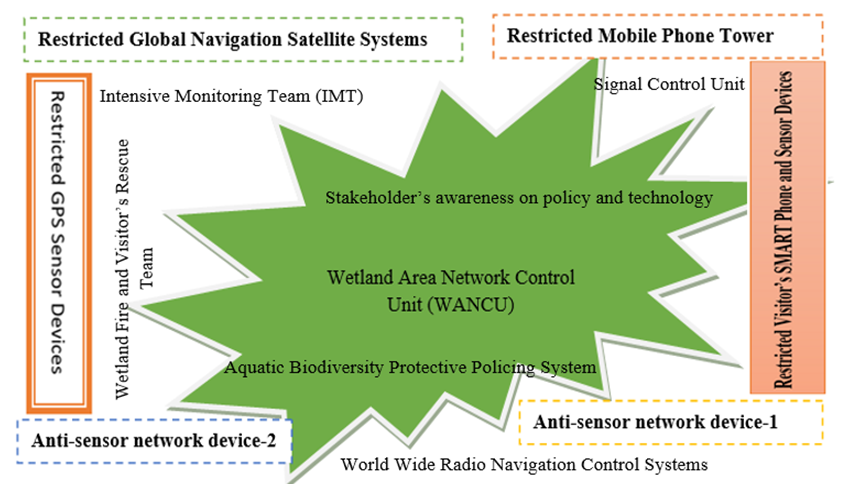 | Figure 8. Innovative Model for Protection of aquatic biodiversity in wetland |
10. Challenges
- There are several challenges for setting-up innovative sensor network approach at wetland area for protection of aquatic biodiversity, such as (i) misusing of innovative technology due to lack of dynamic security, (ii) Voice coding through misusing of integrated artificial intelligence and internet of everything, (iii) produce sensor diseases like CASID (Common Acute Sensor Infections and Disorders), (iv) aquatic biodiversity crime, (v) sensor earthquake and tsunami, (vi) Infodemic message and interface for creating phobia at wetland area, (vii) visitors’ misusing of wireless sensor nano-technology, (viii) expansion of innovative technology without proper security at wetland areas. Because of processed wireless sensor networks, wetlands burn in a fixed GPS location with losses of aquatic biodiversity. But misusers expose to media as environmental problems or climate change or boating related deaths or poisonous or venomous etc. Actually cyber hackers misuse the innovative sensor technology to loss of biodiversity within a fixed GPS location. The rationalized generations involve in good or harm activities to any human in the world through wireless sensor networks through hidden codes [28]. They are scattered among different groups of society and are arbitrarily abusing it [9]. Some stakeholders stay in superstition and some are lack of sensor knowledge. Some scientists remain in mysterious in expansion of innovative nano-sensor technology. According to Transparency International Bangladesh (TIB), a tripartite syndicate is responsible for wetland filing violation in Bangladesh [24]. Moreover, global sea level linking wetland expected to rise by 40 inches (one meter) or more by century’s end [25]. Healthy wetlands can help solve the global challenges of climate change, human health, biodiversity and water security [30]. Government of Bangladesh (GoB) has taken a massive plan to recover wetlands for conservation of aquatic biodiversity [26].
11. Conclusions
- The study assessed that the existing conservation policy instrument is inadequate for wetland aquatic biodiversity protection in Bangladesh and other countries due to a lack of secure networks. In addition, the study identified issues that should be the main priorities for policy integration, implementation, and improvement with the technological array to foster wetland’s management objectives for ensuring sustainable conservation practices. The improvement of wetland policy instrument assessment has been sluggish, compared with several other conservation tools, and various performances are still below par. Scientific knowledge is indispensable in wetland biodiversity management but such knowledge is poorly identified. The input uniqueness of research findings should influence the assessment of the conservation policy instruments used to deal with them. If an assessment of such instruments is allowed without due to the reflection of information implicated, there is huge jeopardy of recognizing only trifling impacts and near to the ground effectiveness. However, careful assessments can facilitate future research to make better conservation decision-making in the creation of environmentally fundamental and secure innovative technological instruments. Lastly, the study suggests future research trajectories of a new collaborative alternative approach to drive the practical agenda and supports linking with Ramsar Wetland Conservation Policy, National Wetland Policy, Aichi Biodiversity Targets, and Sustainable Development Goals 2030.
12. Declarations
- FundingThis research work is a part of PhD Thesis, which was funded by the Zamalah Postgraduate Scholarship of UNIMAS, Malaysia and also sponsored by the Information and Communication Technology Division, Ministry of Posts, Telecommunication and Information Technology, Government of People’s Republic of Bangladesh. The funders had no role in the design of the research, in data collection, analyses or final interpretation of data, in the writings of the manuscript, or in the decision to publish the findings.Data AvailabilityThe data are being used to support the findings of this research work are available from the corresponding author upon request. Competing InterestsThe authors declare no potential conflict of interests in this research work.
ACKNOWLEDGEMENTS
- The authors acknowledged the authority of Universiti of Malaysia Sarawak (UNIMAS), Malaysia for providing the Zamalah Postgraduate Scholarship for the completion of PhD degree. The authors are also grateful to the authority of the Information and Communication Technology Division, Ministry of Posts, Telecommunication and Information Technology, Government of People’s Republic of Bangladesh, for PhD Fellowship during the higher study in Malaysia. The authors acknowledge to the Chief Conservator of Forest, Government of People’s Republic of Bangladesh for presentation this issue at Forest Department Hall Room in Dhaka Head Office. The authors acknowledge to the Honourable Deputy Commissioners of Sylhet and Sunamganj Districts for sharing with presentation in 2019 at Conference Hall Rooms regarding these issues. The authors acknowledged the authority of North East Medical College & Hospital (NEMCH), Sylhet, Bangladesh for kind supports. The authors also acknowledged the higher authority of International Conference on Sustainable Fisheries (ICSF)-2019, Sylhet Agricultural University, Sylhet, Bangladesh for oral and poster presentations at Amanullah Convention Centre.
Appendices
- Wetland biodiversity and relevant others are being destroyed or killed by cyber hackers through misuse of processed wireless sensor networks within GPS locations. These cyber hackers are a group of students, visitors, digital killers, bloggers, strangers, newcomers, adjacent shalterers, supporters, support assistant, fugitive, plotter or syndicate introducer, news builders, cameraman, SMART recognizer, photographer, changer group, renters, surveyers, sudden communicators, suspected figured person and peculiar person etc.
 | Figure 9 |
 | Figure 10 |
 | Figure 11 |
 | Figure 12 |
 | Figure 13 |
 | Figure 14 |
 | Figure 15 |
 Abstract
Abstract Reference
Reference Full-Text PDF
Full-Text PDF Full-text HTML
Full-text HTML